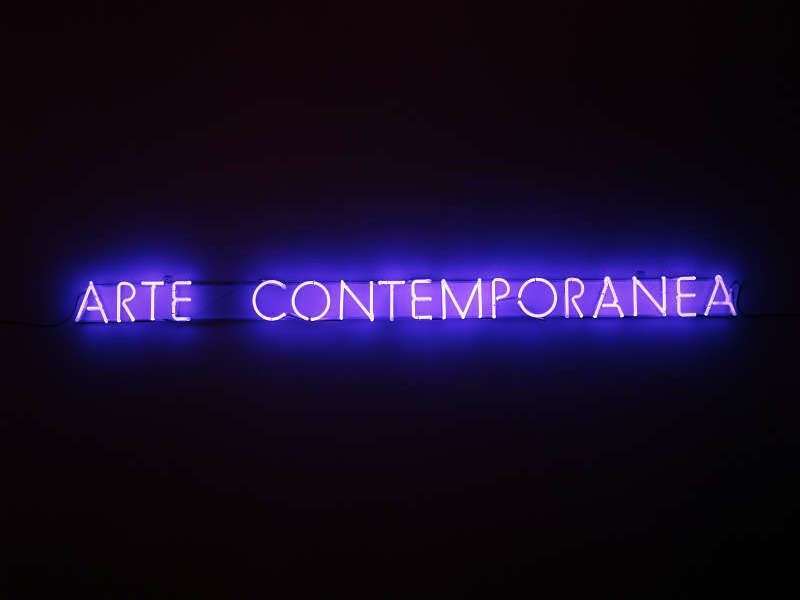
Accueil > Les rubriques > Images > Between Code and Intuition
Between Code and Intuition
Artwork according to Nello Teodori
, et
Toutes les versions de cet article : [English] [italiano]
Nello Teodori tells, for the fifth article of Las Italias, the long journey of artwork : from its birth in ideas’ dimension to its completeness in the viewer’s consciousness.
Born in Gualdo Tadino in 1952, as an architect, a painter and an all-round artist, over the years Nello Teodori has built up a considerable corpus of artworks, starting from somekind unusual roots. His architectural studies in Rome get him in touch with abstract painting : during that period of cultural fervor, keeping himself away from the scene of Piazza del Popolo and coffee Rosati, as a young student instead Teodori became fascinated by the Quadrenniale, by the colored geometries by Piero Dorazio, and by the contamination of different languages carried out by Visual poetry.
His research direction got a significant new impetus with ... Ciò che tu vedi non esiste... (What you see does not exist) a collage of 1980 where the word that gives the title to the work stands on the copy of a photo of Marilyn Monroe as a pin-Up.
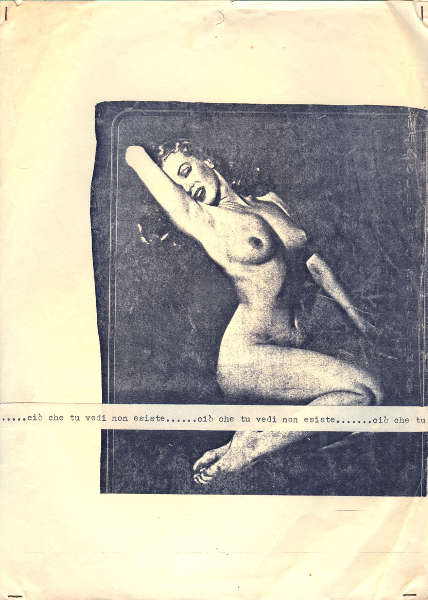
- …ciò che tu vedi non esiste…
1980, Collage, 21 x 29,7 cm
The image coming from a magazine, stands as an object trouvé while the writing belies its appearance, triggering a mechanism for reflection on the vision that goes with Teodori throughout its production.
In the same year, in Venice, the architect Paolo Portoghesi is appointed as the Director of the first Architecture Biennale entitled La presenza del passato (The presence of the past) and opens a reflection upon the Post Modern, better known as the movement that brings into question the myths of modernity, such as "new", technology and the purity of geometric shapes, in favor of a synchronic vision of history, by which architects are called to freely recover shapes, styles and decorative elements.
This reflection becomes walkable space through the Strada Novissima, an installation made of twenty facades, each designed by a different architect, and assembled as wings of a theatre stage of a hypothetical "road" made up of postmodern buildings inside the Corderie dell’Arsenale in Venice.
A nearly three hundred meters long gallery where the post-modern vision identifies a look toward the form and the compositional elaboration that somehow rooted in the classical and influencing the activity of Teodori as an architect, artist and designer.
Starting from the conception of the role he is called to play : in fact, his work is in fact characterized by interests linked to the idea of humanistic and Renaissance derivation, that the architect should be a man of culture, an intellectual, an artist as well as a design architect.
In this sense Teodori has never chose an exclusive field of expression, instead devoting himself to architecture, design, figurative arts, teaching and restoration.
One of the first art exhibitions is Arte Contemporanea (Contemporary Art - Rome, 1991) in which the neon writing "Art" in fact is shown as a tautological element, separate from nouns which it generally refers (museum, exhibition , gallery) to regain the universal and supertemporal valence that finds in the hic et nunc its legitmateness : the art is, by its nature, always contemporary.
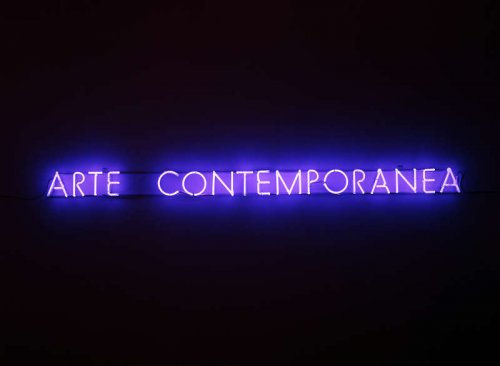
- ARTE CONTEMPORANEA
1991, Veduta parziale dell’installazione alla Galleria Paolo Vitolo - Partial view of the installation at the Galleria Paolo Vitolo, Roma-Rome, Neon, 184,5x10cm
The reflection then becomes not aesthetics, but substantial, as stated by the notary deed which accompanies the work, as if to certify the "artistry", « [...] the word declares itself as "artwork". What is out (alphabet, description, appearance) is also within (essence, vitality, work). The meaning warms the word and the word turns into artwork do you work ».
The work seems to encourage the viewer to question about the real value of the expression, to wonder, therefore, what is contemporary art, what determines its legal and trading value.

- Ho perduto la memoria
1980/2012, Penna su carta - Ink pen on paper, 21x29,7cm
The claim inherent in Arte Contemporanea is also the expression of a survey on time and perception which finds expression in other works, where through simple notices as Ho perduto la memoria (I lost my memory) the element of visual poetry comes back even if it is bent to reflection on exclusively visual language, looking for that "short circuit" the artist pursues to tenaciously, by using photographic images which seemingly random to which he affixes unsettling and decontextualized notices, in an elegant détournement which aims to stimulate the viewer .

- Ho perduto la memoria
1980/2012, Collage, 21x29,7cm
This is the case even in Opera a regola d’arte, (a well done artwork) (Bologna, 1992) in which the expression itself can be interpreted on different levels of consciousness : as it is related to the quality of the performed work, as in the terms of architectural technical document or in "aesthetic" evaluation, or it may refer to working or individual ethic and, breaking the traditional frame between vision and perception, pushing the perception itself to interpretation.
Along the same path arises a crua di Nello Teodori (curated by Nello Teodori - Milan, 1994) a solo show in which Teodori makes a role reversal between artist and curator, putting into question the strict separation of areas established by " art insiders" and working a mixing of art institutional rules, along the way of paradox.
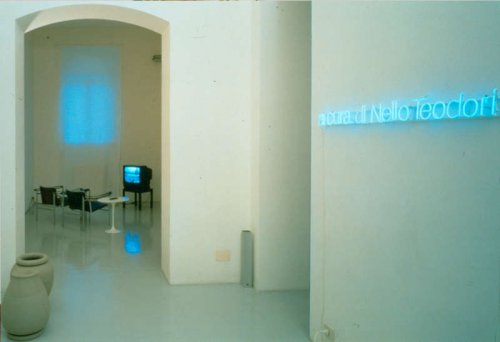
- a cura di Nello Teodori
1994, Veduta parziale dell’installazione alla galleria Paolo Vitolo - Partial view of the installation at the Galleria Paolo Vitolo, Milano - Milan
The language mold production, in which it is impossible not to recognize references to Conceptual art in general and in particular to Jopseph Kosuth, is accompanied by video, in which the artist often gives rise to the ready-made philosophy, using movies coming from advertising or information, which overlaps text or audio tracks that modify their meaning.
This is the case of Smoke (Venice, 2009), which arises from the papal designation whose results are announced by conclave through a cloud of white smoke (that is black in case of failure). In the video, on the images of the chimney emitting a wisp of smoke, superimposed texts that reflect -in different order- what some voices tell run, creating a new core of meaning that culminates in the ironic voice of a famous Italian comedian, along the line of non-sense.
Smoke, a cura di – curated by Nello Teodori, Immagini-images : Elezione del Papa 2005 - TG1 RAI, Testi-texts : Arte e Gnocchi alla Biennale, 1997 - Canale 5)
The same happens in Codice Bianco (White code, 2009) in which the artist relates the futuristic images of classic American films, such as Friz Lang’s Metropolis or Charlie Chaplin’s Modern Times, with a his own text and some drawings inspired by futuristic architecture and Russian Constructivism.
The images in the video construct a sort of mental landscape, a path through the western imagination, but the frames are reassembled into the viewer’s consciousness as a new element that is uniformed by an intellectual and cromatic code that denies their familiarity to encourage reflection on the artwork meaning.
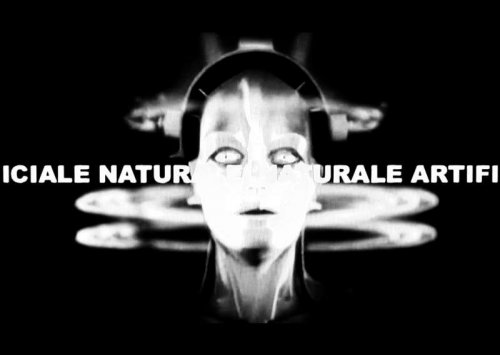
- ARTIFICIALE NATURALE NATURALE ARTIFICIALE
2009, Immagine dal video - still from the video Codice Bianco, 60x40x2 cm
In other video works, instead, the images are shot by the author, often using non-professional actors and détournement is entrusted to the music. This is the case of Avanti Popolo (Forward People – Gubbio, 1994), an installation made up of fifty metal tables bearing the slogan "Avanti Popolo" that stands on the steps of the Renaissance Ducal Palace in Gubbio, installation which is then "finished" and completed by the visitors in the act of climbing the staircase itself.
This installation has given rise to two different videos, the first involvies different characters -some in period costume, others in contemporary dresses -climbing the stairs accompanied by the sound of army footsteps and by the patriotic song La Leggenda del Piave (the Legend of Piave).
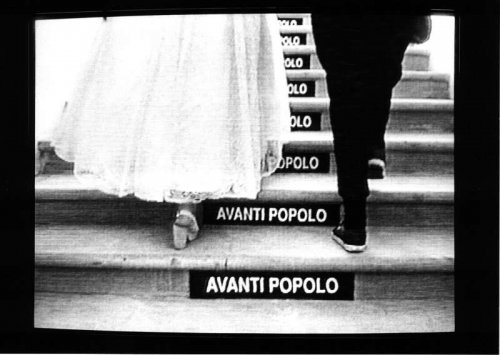
- AVANTI POPOLO
1994, Immagine dal video – still from video Avanti Popolo, Foto su alluminio – Photograph on aluminium, 40 x 30 cm
In the second version Avanti Popolo 1994/1998 (Milan, 1998), the infantry soldier of the previous video (wearing the uniform of the artist’s national service) runs the stairs at full speed, always alone, while The Legend of the Piave the Italian national anthem and Viva l’Italia a song by the singer-songwriter Franceco De Gregori (a song very critical to the country).
Avanti Popolo 1994-1998, video
Although the work of Teodori may seem politically deployed, his analysis concerns for the most part the nature of ideology rather than a specific ideology.In fact the expression code adopted by the artist deliberately conveys than those codes traditionally used for communication and for political propaganda.
This concept is particularly in evidence in the work L’Arte non è uguale per tutti (Art is not equal for all), a photographic work of 1993 (then it becomed also a video) where the expression that gives the title to the work stands on the banner of a group of people who seems to move in a picket, on the balcony of a building site. In reality, the picture is misleading and perception is influenced by the slogan and in some way directed towards a unique interpretation of the image.
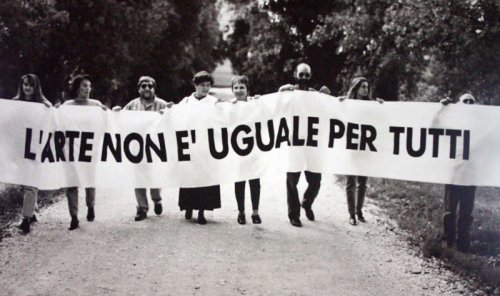
- L’arte non è uguale per tutti
1992, Fotografia su alluminio - Photograph on aluminium, 120 x 80 x 3 cm
But, if on one hand, the composition of the photo and the text of the banner recall the typical images of a protest, on the other, the text stands as an interrogative element of what is art or declaring that art is not equal for everyone and pushes each one to wonder what art is, thus opening up a discussion on "codes" by which we can interpret an artwork .
While it is undeniable that the sense of some contemporary artworks can eludes the public and generate remarkable misunderstanding about the intentions of their authors, it is true that the shared knowledge of the -historical, sociological, cultural, artistic and even biographical- coordinates that led to its birth, is the only form of legitimacy of the interpretation itself.
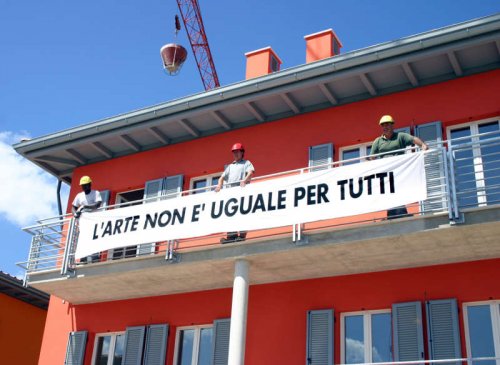
- L’arte non è uguale per tutti
1992, Fotografia su alluminio - Photograph on aluminium, 120x80x3 cm
Similar effects are exercised by video Supera il confine istituzionale dell’arte (Exceeds the institutional art border - Venice, 1992) in which the call to politics is particularly evident and in in the installation and La città non è uguale per tutti (The city is not the same for all - Perugia, 1993) in which the video, photographic images and the huge banner offer the same dynamic.
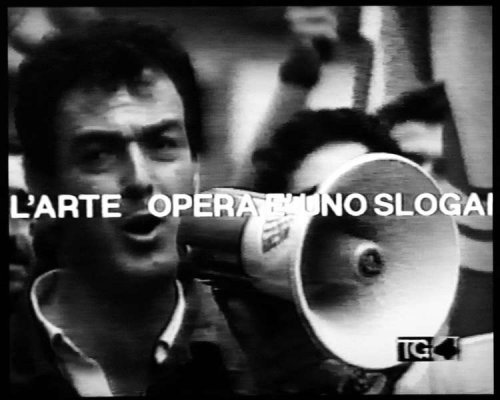
- Opera è uno slogan sul sistema dell’arte
1992, Immagine dal video – Still from the video Supera il confine istituzionale dell’arte, 50x40x2 cm
However, considering the artworks only as "texts" bearing messages that can be interpreted according to specific rules, with an almost mathematical approach, is a very simplistic and in many ways wrong solution. In Teodori’s works in fact the multiplicity of media discloses a design dimension and a creative-arranging process that does not complete as it is the creative act, accompanying instead to an irrational and sometimes random origin.
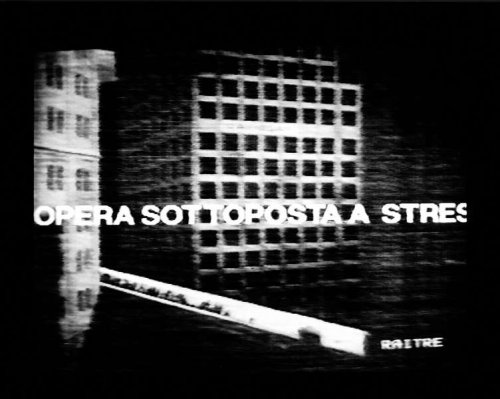
- Opera sottoposta a stress interattivi
1993, Immagine dal video – Still from the video La città non è uguale per tutti, 50x40x 2 cm
Intuition is an essential component of every job and the use of different media allows the artist to combine it in different ways, where imperfection or error are no stranger, and sometimes error becomes the key element of the work itself.
This insight is the origin of "making" art, Teodori in fact considers the artist’s activity similar to that of Plato’s demiurge, committed to turn the invisible into visible, to bring out through an intuitive process that already exists in nature.
This vision -which could recall the Beuys’ shamanism but it differs from it thruogh the behavioral and "action" element that is not found in Teodori- implies the need for the artist to use many different techniques and media to give Art a shape.

- La città non è uguale per tutti
1993, Installazione alla – Installation at Galleria Piano Nobile, Perugia
A confirmation to this effect comes from the exhibition called Medialismo (Rome, 1991) in which the specific process of the artist fits into a movement, theorized by the art critic Gabriele Perretta, where -as for the post-modernist architecture- styles and pictures are available to the artist who wants to use them, taking them from the field they specificallybelong to give them a new meaning, mixing techniques and media, creating an integrated art, or « [...] painting can be depicted as a digital photo, a video can be treated as a painting, a digital message enclosed in a floppy can become an artwork and so on. With the continous development of communication techniques and technologies, the Medialismo can be considered an art always on the move, constantly updated, or "in progress" in its language and in its contents1 ».
Teodori is included into the so-called analytical Medialismo2, he likes to mix languages and media, he develops elaborated installations that involve the viewer in his research, upsets the traditional references and roles of art, going beyond its institutionalization in a continuous meta-linguistic, textual and sociological but also in the broader sense of the term cultural analysis.
The project aspect always in equilibrium with the artistic side and particularly tied to the language is found in Ciao (Hello - Florence, 2004) a permanent installation made by the word in polished aluminum equipped with lights that make it visible even at night. It combines the semantic function of the word with the conceptual function of the artwork and with the practical use of an object -it is in fact a bench- enclosing the polisignificanti instances Teodori’s work always highlights to.

- CIAO
2004, Installazione permanente – Permanent Installation, Parco Pettini Burresi, Firenze, Acciaio - Steel, neon, 700x110x50 cm
Sometimes these instances are accompanied by a stinging irony, as in the case of Scuderie nell’arte (Stables in art - 1997), a project that brings together a team made of diverse group of artists, performers, experts in science, breeders in a stable in Gubbio.
The title of the project, while it refers to its location almost tautologically -a true stable-, on the other hand refers with irreverent humor to membership of the artists to a "stable" of art gallery, with all that such membership entails.
The documentation is made by the book with the same name in which Teodori writes a text entitled A briglia sciolta (Full gallop) whose protagonist is the "Infant" or a horse that embodies all the qualities (beauty, monumentality, etc.) but that one morning wakes up being an ass and thinks that not all evil comes to harm. It’a a kind of metaphorical ransom for this animal, which finds fulfillment in a museum Teodori has dedicated to him and in which are collected works of visual art, poetry, essays, articles and short stories where ass is protagonist.
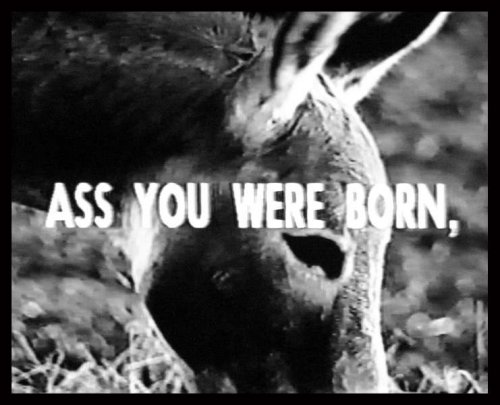
- Ass il somaro
1994, Immagine dal video - Still from the video Ass il somaro, 50x40x2 cm
Outside the metaphor, the invitation that the artist seems to put is to look beyond the surface and the appearance to perceive and experience the nature of things and to reflect on their meaning in the first person. This invitation is valid, a fortiori, in the case of artworks, to reading of which Teodori highlights the need for a common and shared code.
The choice of "word" as an element for the completion of the work or of familiar images in the video processing is just one of the possible solutions. His research continues along the subtle balance between rationality and intuition, where idea becomes a work of art.
Voir en ligne : Nello Teodori’s website
1 V. Selleri, Il Medialismo nell’arte, in Il Cristallo, Year LI - n. 2-3 – December 2009 (online :http://www.altoadigecultura.org/pdf/r04_12.html#)
2 Perretta recognizes three tendencies in Medialismo : the medial painting, in which the pictorial image deviates from tradition using the codes related to the universe media (eg advertising), the Analytical Medialismo which has its roots in conceptual art and in particular in language analysis and finally a Medialismo belonging to groups, called Companies Medialismo in which the art ork is processed anonymously and community behind a "brand" or a common signature. (Ref. G. Perretta, Medialismi, extracted from : http://www.criticart.it/wp-content/uploads/2006/05/Gabriele% 20Perretta.pdf and V. Selleri, Gli artisti mediali, in Il Cristallo, 2010, LL1 at : http://www.altoadigecultura.org/pdf/r05_10.html)
Aknowledgments :
Erica Prisco for supervision of English translation

